October 27, 2017
Air Date: October 27, 2017
FULL SHOW
SEGMENTS
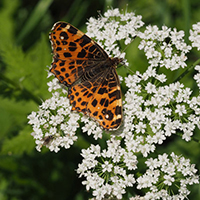
Flying Insects Crash
View the page for this story
The disappearance of many bees and butterflies has concerned scientists and the public for years, and now a new study from Germany confirms that the abundance of all flying insects has dropped over 75% since 1989. Dave Goulson, Professor of Biology at the University of Sussex in the UK, discusses the probable causes with host Steve Curwood, and says the problem is so serious, it could lead to an “Ecological Armageddon.” (11:31)
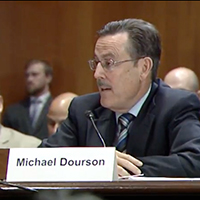
EPA Toxics Nominee Under Fire
View the page for this story
The Trump Administration’s nomination of Michael Dourson to lead the EPA’s Office of Chemical Safety and Pollution Prevention has been met with sharp criticism from environmental and public health advocates. David Michaels, former Assistant Secretary of Labor for OSHA, the Occupational Safety and Health Administration, tells host Steve Curwood that Dourson has frequently provided research for industry to sow doubt about the ill effects of toxic chemicals, and should not be trusted to put public health and safety first in regulating. (05:46)
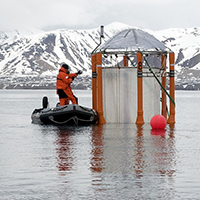
Rising CO2 & Sea Life
View the page for this story
A new analysis finds that most if not all marine species will be affected by the rising acidity in the oceans from CO2 emissions. Research scientist Ulf Riebesell of the GEOMAR Helmholtz Centre for Ocean Research in Kiel, Germany spoke with host Steve Curwood about his team’s findings and what increasing ocean acidity could mean for species like corals and cod as well people who depend on the sea for food. (10:05)
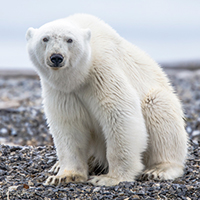
Hungry Polar Bear
/ Mark Seth LenderView the page for this story
On a trip to the warming Arctic, Living on Earth’s Explorer in Residence Mark Seth Lender finds plastic is ubiquitous and polar bears are hungry. (02:36)

A Farewell to Ice
/ Helen PalmerView the page for this story
Year by year, the Arctic sea ice cover is dwindling, driven towards seasonal extinction by global warming. And the vanishing ice is having profound effects on the rest of the world. In A Farewell to Ice: A Report from the Arctic, polar researcher Peter Wadhams describes what’s happening to the thawing world in the North, drawing on his decades of study there. Living on Earth’s Helen Palmer spoke with Wadhams about the crisis facing our planet and what might be done to thwart disaster. (14:51)
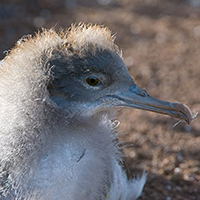
BirdNote®: Spooky Shearwaters
/ Michael SteinView the page for this story
Upon first exploring the Indian and Pacific Oceans, European sailors were horrified by the haunting moans of seabirds called Wedge-tailed Shearwaters, as BirdNote’s Michael Stein explains. (02:10)
Show Credits and Funders
Show Transcript
HOST: Steve Curwood
GUESTS: Dave Goulson, David Michaels, Ulf Riebesell, Peter Wadhams
REPORTERS: Mark Seth Lender, Helen Palmer, Michael Stein
[THEME]
CURWOOD: From Public Radio International, this is Living on Earth.
[THEME]
CURWOOD: I'm Steve Curwood. Three-quarters of the insects that used to buzz around the countryside twenty-five years ago have disappeared – and it’s not good news.
GOULSON: Flying insects, most insects, they make up the bulk of life on earth. They pollinate more than 80% of all the plant species, they help to keep pests under control, they recycle dung, and they’re food for the majority of other creatures...essentially take away the insects and everything else is going to collapse.
CURWOOD: Also, a third of the global warming gas CO2 winds up in the ocean – turning it more acidic…
RIEBESELL: If we don't turn around the present change in ocean warming and acidification we will lose over 50% of the coral reefs in the next couple of decades, so very fast. Those changes are happening.
CURWOOD: That and more alarming news, this week on Living on Earth – Stick Around – if you dare!
[NEWSBREAK MUSIC: Boards Of Canada “Zoetrope” from “In A Beautiful Place Out In The Country” (Warp Records 2000)]
[THEME]
Flying Insects Crash
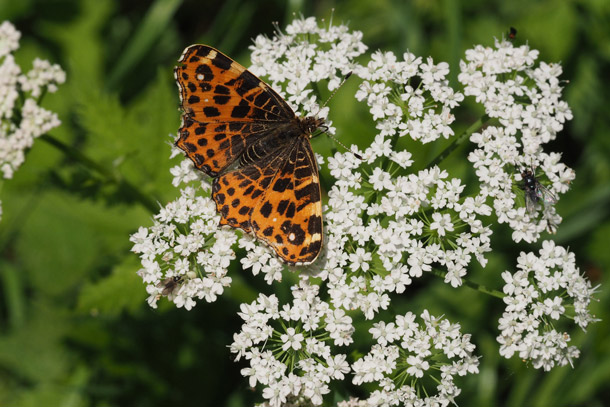
The abundance of flying insects has dropped by over 75% in the past 25 years based on data from nature reserves across Germany. (Photo: Michael Mueller, Flickr CC BY 2.0)
CURWOOD: From PRI, and the Jennifer and Ted Stanley Studios at the University of Massachusetts, Boston, this is Living on Earth. I’m Steve Curwood. Well folks, there is a bunch of troubling news this week. For starters, scientists who are studying a surprising loss of flying insects are calling it “Ecological Armageddon.” Of course insects can be annoying or even dangerous, from flies that carry cholera and dysentery to mosquitoes that spread West Nile and malaria. But butterflies and lightning bugs are beautiful and charming, and others can be friendly, like the dragonfly. And insects work very hard to feed us. They are also food for birds, bats and frogs, and they pollinate many plants, including food crops central to human civilization. But now civilization is destroying them. The journal PLOS One reports that amateur entomologists in Germany have discovered that since 1989, some three-quarters of flying insects there have vanished from nature preserves. Study team member Dave Goulson teaches Biology at the University of Sussex in the UK and I asked him why this is such a perilous development.
GOULSON: So, flying insects, most insects, they make of the bulk of life on Earth. About two-thirds of all species we know are insects. They pollinate more than 80 percent of all the plant species on Earth so if we lose the flying insects we will lose all the flowers on Earth, literally all of them. Flowers evolved to attract insects, that's why we have them. Three quarters of our crops need pollinating by flying insects. So, we’d have a world without most fruit and vegetables. They do other things too. They help to keep pests under control. They recycle dung and so on, and they're food for the majority of other creatures. So, even if you hate insects and many people do, but most people think birds are rather attractive and like to see them in the garden or whatever. Well, most birds at some stage of their life cycle eat insects. Almost all reptiles, amphibians, aquatic fish, bats, lots of small mammals, all depend on insects. So, essentially take away the insects and everything else is going to collapse.
CURWOOD: You've convinced me that we're in lot of trouble without them. Talk to me about the data that you have looked at here. What is it and how did it come together?
GOULSON: So, a group of German entomologists back in the 1980s took it upon themselves to start insect trapping our nature reserves scattered all over Germany. They used things called malaise traps which look a bit like a small tent which catch flying insects, bump into them and fall into a pot basically, and they've been doing it ever since from their own kind of interest. I got involved relatively recently, a couple of years ago, when this data kind of finally came to light and we realized what a kind of treasure trove of information it could be. And when we started looking at it we couldn't quite believe what it showed, which was just this wholesale disappearance of insects. The daily catch of insects has fallen by three-quarters, a little over three-quarters in 26 years which suggests a scale of insect decline that was just...we knew things weren't going well, we knew that butterflies are in decline and so on but there was very little other monitoring of insects going on and so we had no idea just how dramatic it had been until we saw these numbers.
CURWOOD: What do you suspect is behind this decline? As we were getting ready to talk to you, we raised the question of the neonicotinoid insecticides which started being used in the 80s about the time this decline begins. How much of a suspect are the neonicotinoid insecticides?
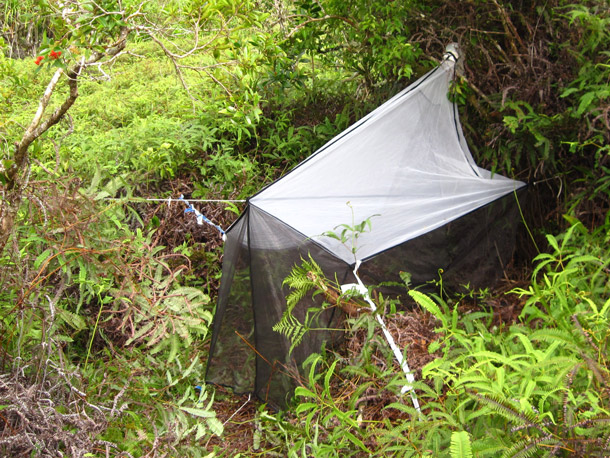
Amateur entomologists used malaise traps, similar to the one above, to capture and measure the weight of flying insects in nature reserves across Germany, starting in 1989. (Photo: ap2il, Flickr, CC BY-NC 2.0)
GOULSON: I think it's very likely they are playing a role. Whether they're the main driver or not is hard to say. The broad picture I think is that essentially the way we grow food these days makes the environment completely hostile to more or less all forms of life. It isn't just neonicotinoids. We grow these huge monocultures of crops, great big fields, which typically in Europe get about 20 different pesticides applied to them, each crop cycle including maybe four or five different insecticides, whole bunch of fungicides, things to kill slugs, herbicides to control the weeds. So, there's just no scope for anything to survive there apart from the crop and if we cover the landscape in fields like that, then we probably shouldn't be surprised when we see wildlife disappearing. These neonicotinoids have got a lot of attention because they are particularly toxic to insects like bees and it takes just three billionths of a gram of one of those things to kill a honeybee and we're applying hundreds of thousands of kilos of them to the landscape every year, so it's undoubtedly contributing to it, to the loss of our insects. But they are just part of the whole system of farming which is entirely dependent on one type of pesticide or another and that's what we need to look at I think.
CURWOOD: Just another detail on neonicotinoids. I gather that they're not exactly being sprayed on the insects that are being lost, but they're in the ecosystem. How does that work?
GOULSON: So neonicotinoids are usually used as seed dressings. The farmer buys seed pre-coated with a layer of insecticide and he sows the seed in the ground and they're water-soluble. They dissolve in the damp soil and they're supposed to be sucked up by the crop plant and they spread to all of its tissues which sounds like a kind of neat system if you're a farmer. It protects the plant against insect pests. The trouble is if it's a flowering crop they go into the pollen and the nectar and then when the bee comes to pollinate the crop, something like oil seed rape, canola, sunflowers, the bee gets a dose of neurotoxin. But there's more to it than that because it also turns out that the bulk of the insecticide doesn't get taken up by the crop at all, it's just going into the soil and accumulating in the soil, leaching into streams or being taken up by the roots of wildflowers or hedge row plants growing near the crops.
So, we're finding these chemicals turning up in places we didn't expect them including the pollen and nectar of wildflowers. So, there was a recent study showing that 75 percent of honey samples taken from all over the world contain nearly neonicotinoids showing just kind of the scale, the ubiquity of these chemicals, that basically if you're a bee anywhere in the world, the chances are your food contains neurotoxins that will kill you at really tiny doses, and that surely can't be a good thing.
CURWOOD: Now, aside from the neonicotinoids, you point out that there are a whole bunch of other chemicals that might be implicated in this dramatic decline. What kind of chemicals are we talking about?
GOULSON: So, there are other insecticides things like pyrethroids and organophosphates. Probably the listeners out there these things don't mean very much, but organophosphates are pretty horrible. They were actually developed in Germany in the Second World War with the aim of killing people. Most of them have been banned but there are still some that are used in farming. There are lots of fungicides. The fungicides, you think well they're not going to harm insects, but actually some of them have this strange effect...they knock out the detoxification mechanism of the bee. So although the fungicide itself isn't poisonous…if an insecticide is simultaneously exposed to a fungicide and an insecticide, the insecticide is effectively much more potent. It can be up to a thousand times more toxic, and then the herbicides just get rid of the weeds so there are no flowers apart from the crop if that flowers. So, although they may or may not be poisonous to the – to the bees directly, if they get rid of their food then that's just as bad, so it's this kind of cocktail, the poor bees, you know, they're going out there, they're struggling to find food and when they do find food it's got a mixture of pesticides in it. And so, we shouldn't really be surprised that bees and other flying insects aren't doing so well.
CURWOOD: So, this is data that was gathered in Germany. I've noticed in the US, for example, where I live, that I don't see lightning bugs anymore, and black flies seem to have a much shorter season in Maine and so forth, but what about the tropics? Is there a similar sort of decline there?
GOULSON: It would be hard to extrapolate with any certainty at all. The tropics are different in many ways that there's still more natural habitat left generally not in all but in most places like the UK and Germany. Essentially everything is managed land. You have some wilderness left in the United States and in Germany in the UK we have none. It's all farmland or cities and little tiny nature reserves scattered amongst them. So, there's no reason to really believe that it wouldn't be similar in most of Europe, in the developed world, but in the tropics we don't know. Clearly there's massive habitat loss going on right now or in tropical countries that we still seeing these devastating loss of tropical forests that for all my life, we've been talking about how we really need to stop cutting down the trees. These rainforests are teeming with life, that they're vital for regulating the climate and all sorts of other things, and yet sadly you know we're still hacking them down to create oil palm plantations and to grow soybean in Brazil and so on. So, my guess is insects are declining there too but I couldn't tell you whether the pace of change is the same or different.
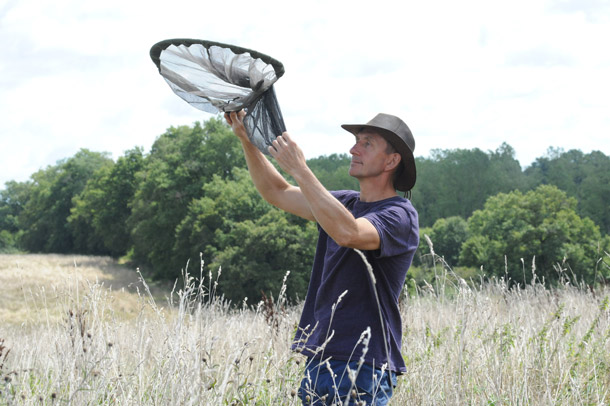
Dave Goulson is a Professor of Biology at the University of Sussex and was part of the team investigating the precipitous insect decline. (Photo: courtesy of Dave Goulson)
CURWOOD: So E.O. Wilson, the biologist at Harvard University, famously once said and I think this is a paraphrase, that if we lost the ants, just losing the ants, we would lose humanity. What do you think this huge loss of insects means for humanity?
GOULSON: If we lose insects we're doomed, I know this sounds overly dramatic but we absolutely are. Life on Earth would be utterly changed. We wouldn't be able to grow our crops. Dung would build up in the fields. Life on Earth would essentially cease, so we absolutely have to take this really seriously, and it's something that I find enormously frustrating that we seem to live in a world where people are very detached from the environment. They don't know where their food comes from, they – they seem to not realize that actually even if you live in a city, we are part of the environment, we depend upon the health of ecosystems to provide us with places to grow our food, to provide clean air and clean water and so on, and that a healthy environment should be our number one priority. Forget the economy, forget the health service, forget the rest of it. None of those things will matter if we don't have a healthy environment because everything else will collapse, and it really – it drives me nuts that politicians on the whole don't often talk about the environment. It gets very little attention and we're always worried about short-term economics and so on, but actually we need to think slightly longer-term and look after the planet.
CURWOOD: Professor, what could be done to slow this trend, this rapid loss of insects?
GOULSON: I'd love to see a major rethink of how we produce food. This idea that we need these great big fields full of monocultures of crops. There are other ways of growing food. I'd love to see it move towards small-scale production, get more people back onto the land and small farms producing food for local consumption. We should really tackle food waste because we grow all this food at huge cost to the environment and then we throw away about a third of it which is absolutely insane. We eat too much meat. If we could convince people not to eat so much beef in particular then that could massively reduce our footprint on the planet, so there are things we could do but they all require buy in from significant numbers of people, you know, one or two environmentalists like me banging on isn't going to do anything. We need the majority of people on Earth to change their ways and that's a pretty difficult thing to achieve.
CURWOOD: Entomologist David Goulson is a professor and biologist at the University of Sussex in the UK. Thanks so much for taking the time with us today.
GOULSON: My pleasure.
Related links:
- PLOS ONE: “More than 75 percent decline over 27 years in total flying insect biomass in protected areas”
- The Guardian: “Warning of ‘ecological Armageddon’ after dramatic plunge in insect numbers”
[MUSIC: Recorded by Yuta Konishi, “Nature Sound 33 - Singing of Insects /The Most Relaxing Sounds,” recorded in Fukui Japan, https://www.youtube.com/watch?v=-amqzDJ45-4]
CURWOOD: Coming up, a rising tide of acid in the oceans is washing out key species.
That’s just ahead on Living on Earth.
ANNOUNCER: Support for Living on Earth comes from the Gordon and Betty Moore Foundation, and from a friend of Sailors for the Sea, working with boaters to restore ocean health.
[CUTAWAY MUSIC: David Chevan/Warren Byrd, “Let Us Break Bread Together” on Let Us Break Bread Together, traditional African-American, Reckless DC Music]
EPA Toxics Nominee Under Fire
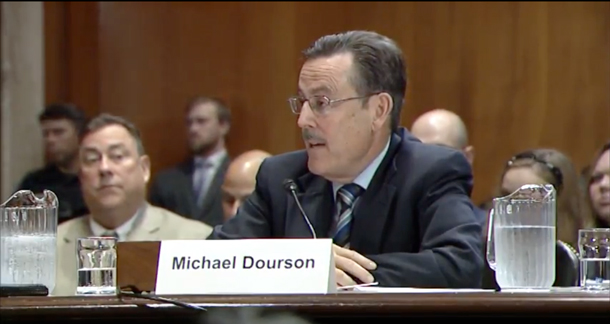
U.S. EPA chemicals nominee Michael Dourson during his confirmation hearing. (Photo: Senate Environment and Public Works Committee)
CURWOOD: It’s Living on Earth. I’m Steve Curwood. EPA stands for the Environmental Protection Agency, but some critics say with Scott Pruitt now as Administrator, the US EPA has become the Environmental Polluters Agency. In a move to boost the fortunes of the carbon-polluting coal industry, Mr. Pruitt wants to roll back the Obama era Clean Power Plan, designed to fight global warming. And the EPA recently prevented its own climate scientists from presenting research at a meeting on the health of the Narragansett Estuary in Rhode Island. A probe by the New York Times has found a former executive for the American Chemistry Council – that’s an industry lobby group – is a key scientist for the EPA’s recalibration of the health risks of toxic substances. And now Michael Dourson is under fire. He’s been nominated to head the EPA’s Office on Chemical Safety and Pollution Prevention. Critics include David Michaels, a former assistant secretary of Labor for OSHA, the Occupational Safety and Health Administration. David, welcome back to Living on Earth.
MICHAELS: It's great to be back, Steve.
CURWOOD: So, why does the possibility of Michael Dourson leading the chemical safety office at EPA concern you?
MICHAELS: Well, it's very unfortunate. My understanding is he's already working at the EPA as an advisor to the office that he's been nominated to run, so he's already in there, but with a confirmed nomination when he's sworn in as assistant administrator at the EPA, when it happens, he'll have a great deal more power and be able to essentially roll back a lot of the important protections that we rely on to make sure we're safe. You know, Michael Dourson is a deeply conflicted scientist. He's done mercenary work for dozens of chemical companies and scores of chemicals, but he's refused to promise to recuse himself from ruling on those chemicals or for other chemicals manufactured by those companies. He's the guy in charge of protecting Americans from toxic chemicals and I don't think he's going to do it right.
CURWOOD: So, what is it about his relationship with industry? I understand he as a consultant group. He founded TERA, Toxicology Excellence for Risk Assessment. It's a nonprofit. What about his relationship with the industry that concerns you so much?
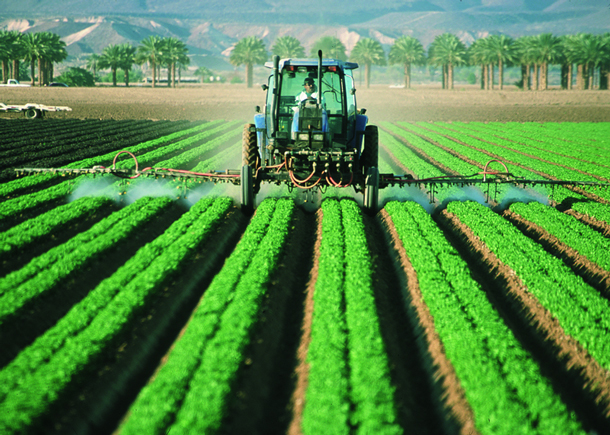
Pesticide application on leaf lettuce in Yuma, AZ. If Michael Dourson is confirmed as head of EPA’s Office of Chemical Safety and Pollution Prevention, he would be in charge of regulating which pesticides and other chemicals can be used in the U.S. (Photo: Jeff Vanuga, USDA Natural Resources Conservation Service, public domain)
MICHAELS: Well, what he's done, he's made a career of applying the tobacco industry strategy of manufacturing doubt and manipulating scientific data to defend toxic chemicals. He even worked for big tobacco long after it was clear that their only commitment to science was to invent results that would delay government action and it's a very successful strategy because no study is perfect, we never have absolute proof, but we need to protect our families, we need to protect our kids by making sure the levels of these chemicals don't get too high.
CURWOOD: What are some of the chemicals on which he's done this, what you say is dubious research?
MICHAELS: He's done this work on this huge range of chemicals from diacetyl which is the chemical that you may remember caused "popcorn lung," it destroyed the lungs of workers who work in popcorn factories because it’s artificial butter flavor. He was working for some of those companies that said look, that's a very safe chemical. The government says it's much less safe, and the government's right. PFOA, which is this teflon product that polluted the water of thousands of people in Ohio and in West Virginia, again, he was brought in to say, look, we don't really need a strong standard here. He's worked on Chlorpyrifos, which is a very very toxic pesticide which Scott Pruitt at the EPA has just overruled all their scientists and said, “OK let people sell it,” even though it causes brain damage in kids.
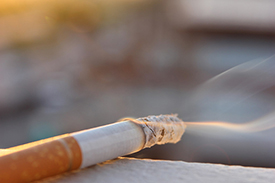
The tobacco industry perfected the technique of the “manufacturing of doubt” on scientific knowledge about risks, David Michaels says. (Photo: Lindsay Fox, Flickr CC BY 2.0)
CURWOOD: What's the nature of the relationship between Scott Pruitt and Michael Dourson?
MICHAELS: I don't know if they have a personal relationship, but given what Scott Pruitt is doing to the EPA in rolling back all these rules, Michael Dourson is the perfect person for him to bring on to look specifically at chemical hazards because Dourson has spent his career really working for industry. You know, industry e-mails reveal that corporate officials felt they could trust him, he was their go-to scientist, always ready to minimize the risk exposures in toxic chemicals to weaken standards that should be strengthened to protect us and our family and our kids. You know, last year, on a bipartisan basis Congress passed a reform of the Toxic Substances Control Act, and it was very promising developing new ways to make sure that Americans are safe from exposure to toxic chemicals. Right now under Scott Pruitt, the EPA is rolling back all the commitments they made under that law, and chemicals that shouldn't be in our environment, chemicals that shouldn't be in our food, will remain there and in some cases the levels will even go up because of this administration.
CURWOOD: You recently wrote an opinion piece in The Hill and you wrote that Dourson "repeatedly recommended chemical exposure levels hundreds of times above established limits." Cite this for me and how did he justify such recommendations, do you think?
MICHAELS: Risk assessment is not a perfect science and it allows some subjectivity, and he pulls together a group of scientists, many of whom have very close relationships with him. They look at the literature. They opine on it. They look at the epidemiology, the human studies, animals studies. They say, “well, it looks like this is a safe level.” And that's what he did with diacetyl. He came up with a number of that was 20 to 40 times higher than what the National Institute for Occupational Safety and Health came up with when they looked at that same literature, and it's wrong and every time a government agency looks at the same issue they say, “We need a much safer level.” but the industry then takes his number and promotes it. He says and his advocates say that what he does he produces sound science, but what he really does is to manufacture studies that sound like science. In reality his results are preordained. He's hired to study a chemical, you can be sure he'll conclude that chemical isn't very dangerous.
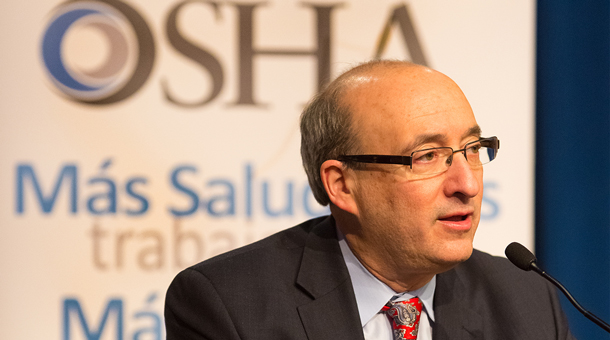
David Michaels is a professor of Environmental and Occupational Health at George Washington University, and served as the United States Assistant Secretary of Labor for Occupational Safety and Health under President Obama. (Photo: George Washington University)
CURWOOD: David Michaels is a Professor of Environmental and Occupational Health at George Washington University. Thanks so much for taking time with us today.
MICHAELS: Steve, it's been a pleasure to be with you.
Related links:
- The Hill opinion by David Michaels: “Trump wants former Big Tobacco ally to run EPA chemical safety”
- E&E News: “Controversial chemicals nominee already at agency”
- The Hill: “Dem senator puts holds on two EPA nominees”
- EPA News Release: “Widespread Praise for Dr. Michael Dourson”
- Michael Dourson as president of Toxicology Excellence for Risk Assessment
- About David Michaels
- NBC:Senate Committee Advances Controversial Trump EPA Nominee
Rising CO2 & Sea Life
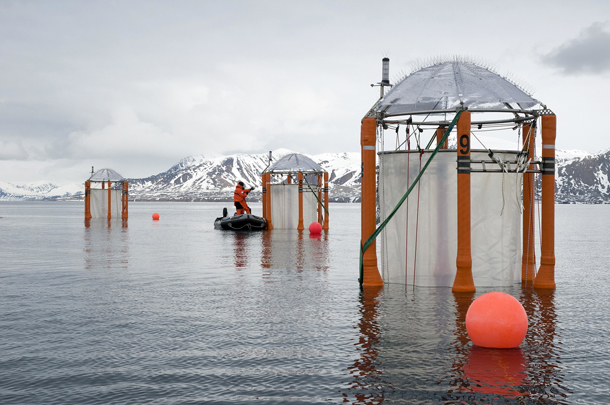
Scientists sampling mesocosms during an outdoor experiment investigating the reactions of marine organisms to ocean acidification in Svalbard, Norway. (Photo: Maike Nicolai, Wikimedia Commons CC BY-SA 4.0)
CURWOOD: So the EPA is required to regulate carbon dioxide as a pollutant because it changes the climate, but CO2 also pollutes the sea by making it more acidic. A new report called “Exploring Ocean Change” from the group Biological Impacts of Ocean Acidification, or BIOACID shows rising acidity leads to habitat loss and disruption of growth and reproduction of sea life. Ulf Riebesell is the lead author of the report and joins me now from Kiel, Germany, where he is a research professor at the GEOMAR Helmholtz Center for Ocean Research. Ulf, welcome to Living on Earth!
RIEBESELL: Thank you very much.
CURWOOD: So, your research found really a diverse response from organisms to the increase in acidification in the ocean. What kinds of impacts could this phenomenon have on life in the sea and on the various organisms?
RIEBESELL: Well, what we see is all groups, all large taxonomic groups in the ocean are affected one way or the other. It could be directly by the direct impact of acidification on individual organisms. It could be indirectly by changes in the habitat or changes in the food web. So, of the 380 studies so far on individual organisms that we have included in this meta-analysis, over 50 percent of the species were directly affected by acidification even at relatively moderate CO2 levels. On top of that, we will have changes in habitat, for example, all the organisms adapted to life in coral reefs. As the coral reefs are disappearing so will the habitat for these organisms, and that's an indirect effect. So, it's a wide array of organisms that will feel the pressure of acidification in connection with ocean warming.

The pH scale is a representation of the acidity of a given substance. But because it’s logarithmic, comparing acidities is not as straightforward as one might assume. (Photo: Piercetheorganist, Wikimedia Commons public domain)
CURWOOD: How do you study ocean acidification? What methods do you use to gather the data?
RIEBESELL: Well, there's a whole range of methods. You can start with test tubes in the lab. That's what has been done in the very beginning of ocean acidification research. Then people have gone to larger containers where they include more and more organisms, and eventually we have come to realize that we actually have to go out into the field to study acidification in natural communities, ecosystems, where all the components of a community come together, and that's why we have developed what we call mesocosms, these big containers which we can put out into the ocean, enclose a large body of water, and then simulate the future conditions by just adding CO2 into some of them at different levels and then we can basically stimulate today's ocean 10 years from now, 20 years from now and so on.
CURWOOD: How much acidification are you talking about here...and put that in terms that people who maybe don't really understand much about chemistry could understand.
RIEBESELL: Well, from chemistry you know we talk about the pH scale and this goes from zero to 14 and the middle of that is what normal freshwater has, about pH seven. That scale is kind of misleading because it's a logarithmic scale. So, if we talk about ocean water before human activity started, it had a pH of 8.2 and now we're down to 8.1. It doesn't sound like much but because it's a logarithmic scale, it means that acidity of the ocean has increased by 30 percent. If we continue to admit CO2 at current rates, then by the end of this century we would be at a change in acidity up to 100-150 percent, so basically doubling the acidity of the ocean in just about 150 years, which would be massive. We hope we're not getting there, and if we stay within the Paris Agreement – two degrees warming – that would also mean that acidification doesn't nearly go as far. But still, as I said we have already acidified the ocean by 30 percent.
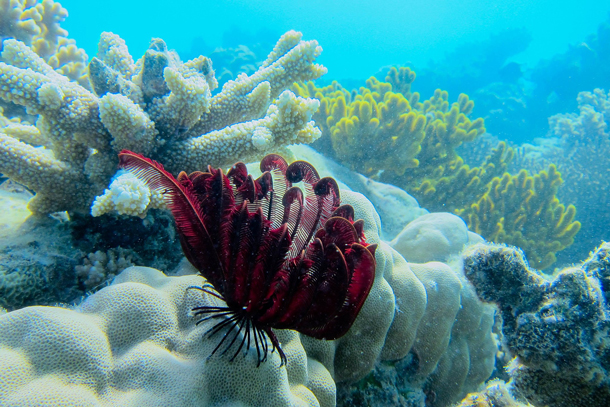
Rising acidity as well as rising temperatures in the oceans are a double hit taking a huge toll on the health of coral reefs. (Photo: Ryan McMinds, Wikimedia Commons CC BY 2.0)
CURWOOD: To what extent are we seeing the biota, various organisms responding now to the increase in acidification in the oceans?
RIEBESELL: Well, we certainly see some of the organisms and even some of the communities in ecosystems to already respond to the ongoing acidification. So, even today we can go out and see some in particularly calcifying organism to be affected. Their shells are thinner, and in cases where they're exposed to what we call corrosive waters where the water is under-saturated with respect to cuts in carbonate, the minerals of which they build their shells and skeletons, we can see that they are dissolving from the outside. Those effects are seen today. We also see that large parts of the warm water coral reefs are already affected by the combination of warming, but also in combination with acidification. If we don't turn around the present change in ocean warming and acidification, we will lose over 50 percent of the coral reefs in the next couple of decades, so very fast. Those changes are happening.
CURWOOD: So, tell me what your laboratory experiments are showing in terms of how species might be adapting or not to acidification in the ocean?

Shellfish like mussels build their shells out of calcium carbonate, which is less available in a more acidic ocean. (Photo: Anja, Flickr CC BY-NC 2.0)
RIEBESELL: That is in fact a very important question. Can organisms adapt to acidification? In our experiments we usually expose them to high CO2, low pH within days or weeks at the longest. In reality they have years to decades to get slowly adapted to this. Is that enough time for them to actually evolve and change their set up so they can deal with it? And what we've done is we've worked with organisms that have very short generation times, phytoplankton, the calcifying phytoplankton, they have generation times of one day, so they reproduce every day. So, that means they go through about 300 to 400 hundred generations a year and we have grown them now for four years, so 1,600 generations.
What we see is they can adapt to some extent. They can be slightly better in dealing with ocean acidification, but they cannot compensate even after so many generations, they cannot fully compensate for the negative effects of acidification, which makes sense because for a calcifier, acidification just means you have to invest more energy into building calcium carbonate, that means you have to make sacrifices somewhere else in growth, in reproduction and whatever. This is with small organisms that have short generation times. If you kind of extrapolate this to organisms with generation times of, let's say a year, then of course 10 years, 20 years only makes 10 to twenty generations. That's by far not enough to be fully adapted.
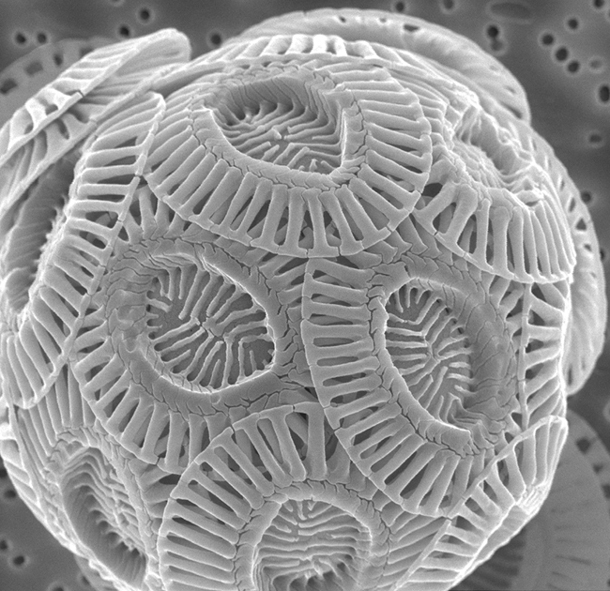
Emiliania huxleyi is a calcifying phytoplankton that must now devote more energy to building its complex structure as acidity increases in the oceans. (Photo: Alison R. Taylor / University of North Carolina Wilmington Microscopy Facility, Wikimedia Commons CC BY 2.5)
CURWOOD: What about some of the species in the ocean that been important economically and gastronomically to humans, for example, cod in the North Atlantic? How are they responding to increased acidification as far as you can tell?
RIEBESELL: So, we're very interested in looking at economically important species. We took cod larvae and juvenile fish of cod into the lab and exposed them to high CO2 and what we saw is that their survival is very much reduced under high CO2, low pH and this makes sense because larvae and juvenile fish usually don't have very good pH regulation in their body. It takes basically until they have fully developed their gills. That's when they start being under full control of pH. We then used those lab results and put them into some recruitment models where we have stock developments of cod in the North Atlantic and what it showed is if we use this 50 percent reduction in larvae survival, what it means in terms of stock recruitment is that we could have down to one quarter to even one-tenth of the stock production in the future ocean, and this is something we definitely need to consider when we talk about fish catches in the future and how much we can allow fisherman to take out of the ocean.
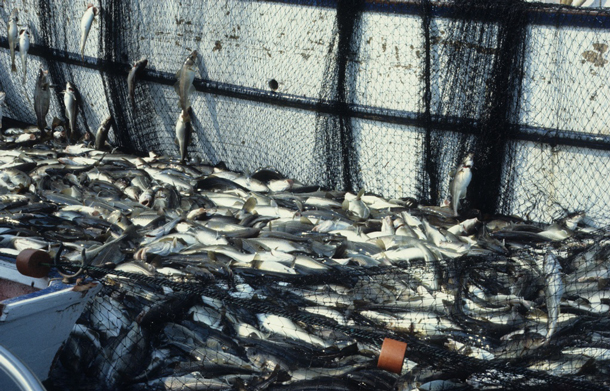
Atlantic cod are an important food source for much of Northern Europe, but increased acidity impacts their survival rates as juveniles and is projected to severely reduce fish stocks. (Photo: Derek Keats, Wikimedia Commons CC BY 2.0)
CURWOOD: Who is going to feel earliest and strongest the effects of ocean acidification around the world?
RIEBESELL: It's the same thing as with climate change. It's the poorest people that will feel this first. If you just look at the last FAO report, they say that about one billion people on our planet have protein from the ocean as their most important protein source, but these people mostly live in the poor counties. So, those one billion people will be affected by acidification most.
CURWOOD: And FAO, of course, stands for the Food and Agricultural Organization of the United Nations. So, what could be done in the near term to reduce ocean acidification, aside obviously from…from reducing the production of CO2. What technical things might be done?

Ulf Riebesell is a research professor at the GEOMAR Helmholtz Centre for Ocean Research. (Photo: GEOMAR Helmholtz Centre for Ocean Research)
RIEBESELL: Globally, it's almost impossible to change that. The global ocean is directly affected by CO2 emissions, will take up one-third of what we produce every day, so if we take our car from home to work and back, one-third of that CO2 goes directly into the ocean. There's nothing we can do about it unless we reduce our emissions. Locally or regionally, we could do something, for example, ecosystems like coral reefs that we value very highly that we do not want to lose, we could save by planting algae and sea grasses around these because by photosynthesizing they will take up CO2 from the ocean, they will increase PH in the seawater. We could even think of some lime in the waters around these coral reefs and thereby increase PH slightly, but it just provides another reason to do what we already know has to be done, which is reducing CO2 emissions.
CURWOOD: Ulf Riebesell is a Research Professor at the GEOMAR Helmholtz Center for Ocean Research in Kiel, Germany. Thank you so much professor for taking the time.
RIEBESELL: Thank you very much.
Related links:
- BBC: “More acidic oceans ‘will affect all sea life’”
- BIOACID: “Exploring Ocean Change” ocean acidification report
- About Ulf Riebesell
[MUSIC: Sambada, “Casa de Mainha” on Gente! Cali-Bahia Records/Santa Cruz]
Hungry Polar Bear
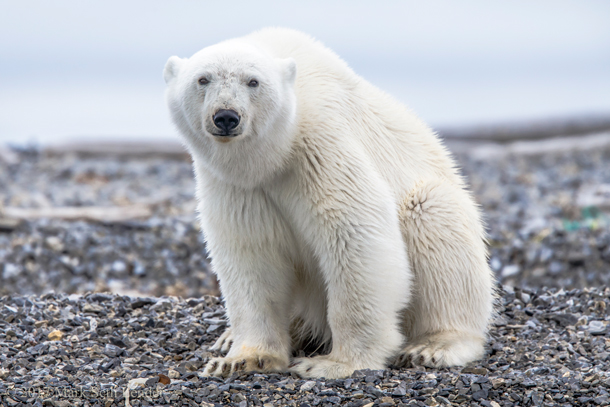
Without access to sea ice to hunt seals, a polar bear’s chances of finding fat and protein-rich meals are much slimmer. (Photo: Mark Seth Lender)
CURWOOD: As arctic sea-ice melts, polar bears find themselves these days on ice-free land, littered with plastic and washed up garbage, and without any good source of food. That has hungry bears looking for alternatives, which Living on Earth’s Explorer in Residence, Mark Seth Lender found rather disquieting.
Big White Dog Wants to Play!
© 2017 Mark Seth Lender
All Rights Reserved
LENDER: The Big White Dog pads down the rocky beach, towards shore, 600 miles from the Pole. Someone’s come to visit him. Oh boy! He’s been sooooo boooored. No one to, ah, play… with…. No one to run… with… No one to throw him doggy treats though right about now Big White Dog would much prefer a bleeding hunk of red… meat…. Well-marbled. The fatter the better. Cholesterol’s not his enemy, only the weather. Which right about now is warm. Toooooo warm! And all his play… mates…. They’re gone. He’s not sure where. He sure does hope they’ll be back… soon... Right where they used to be only a couple of yummy months before.
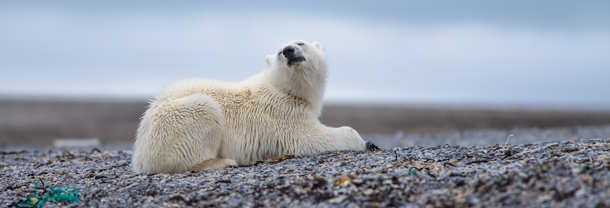
A polar bear on an ice-free shoreline. (Photo: Mark Seth Lender)
But in the meantime here are all these New… Friends… In their friendly rubber boat! There are so many of them to choose… from… It’s so hard to decide he has to sit himself down like a Good! Dog! On his Big White Paws. With railroad spikes for claws and his canine teeth like the rule of law in this… lawless… place.
And like all polar bears he has that goofy smile from his blue-black lips following the line of his jaw. He is so fluffy! And furry! You can’t imagine he’d do you a lick… of harm.
Big White Dog picks at the carcass of a long-dead bird and chews the feathers, spits out the bones, and wishes the whole thing tasted better. And walks, inland, over the plastic that decorates the flotsam line in red and blue and green, and the sticks that were a forest in Siberia cut down and washed up here, and water-rounded lumps of coal, and fishing gear, and the oil slick.

Plastic and other pollutants litter this rocky Arctic habitat. (Photo: Mark Seth Lender)
And it’s polar bears we fear.
CURWOOD: Mark Seth Lender’s pictures of the hungry polar bear are at our web site – loe dot org.
Related links:
- Read Mark Seth Lender's Field Note from this story on plastic pollution
- For more about polar bears, visit Mark’s website
- Support for Mark’s fieldwork was provided by One Ocean Expeditions
[MUSIC: Ultimate Christmas Solos
Believe (from The Polar Express) - Play Along, Glen Ballard/Alan Silvestri 2013]
CURWOOD: Coming up...less and less ice for the dog days of summer. That’s just ahead here on Living on Earth. Stay tuned.
[MUSIC: Ultimate Christmas Solos Believe (from The Polar Express) - Play Along, Glen Ballard/Alan Silvestri 2013]
ANNOUNCER: Funding for Living on Earth comes from you our listeners, and United Technologies – combining passion for science with engineering to create solutions designed for sustainability in aerospace, building industries and food refrigeration. UTC companies such as Otis, Carrier, Pratt & Whitney and UTC Aerospace Systems are helping to move the world forward. You can learn more about United Technologies by tuning in to the Race to 9 Billion podcast, hosted by UTC’s Chief Sustainability Officer. Listen at raceto9billion.com. That’s raceto9billion.com. This is PRI, Public Radio International.
[CUTAWAY MUSIC: David Chevan/Warren Byrd, “How Much More” on Let Us Break Bread Together, traditional African-American, Reckless DC Music]
A Farewell to Ice
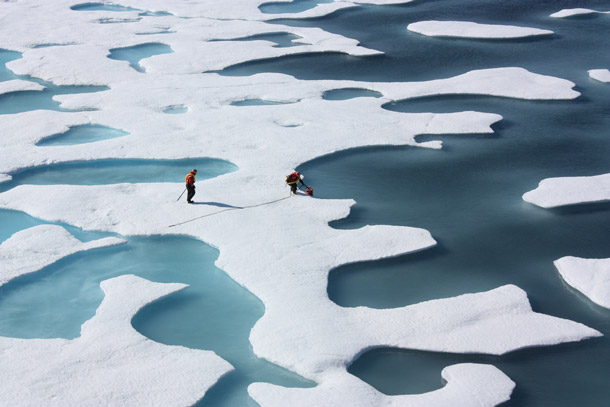
Melt ponds on Arctic sea ice, July 2011. (Photo: NASA Goddard Space Flight Center, Flickr CC BY 2.0)
CURWOOD: It’s Living on Earth, I’m Steve Curwood. The book’s title says it all – A Farewell to Ice. It’s the result of nearly a half-century of personal ice research, mostly in the Arctic, by Peter Wadhams, he’s head of the Polar Ocean Physics Group at Cambridge University. And the fast retreat of glaciers and polar ice is sobering if not terrifying in what it implies for the future of life here on Earth. Living on Earth’s Helen Palmer met up with Peter Wadhams at the Oxford University Press offices in Manhattan.
PALMER: Peter Wadhams, I have to say your book "A Farewell to Ice" paints a very grim picture. How early were you aware that things were going downhill, as it were?
WADHAMS: Well, it took a long time before we realized things were changing, and I think for me, the realization came when, in 1987, I did a submarine voyage over the same grounds that I'd followed in 1976 and found that the ice was much thinner, it was about 15 percent loss of ice over a huge area of the Arctic, so that was my first realization that the situation was not stable.
PALMER: Now, your book is full of incredible graphs and tables and one that I found particularly telling is what you call the Arctic death spiral. Can you explain that to me and describe it?
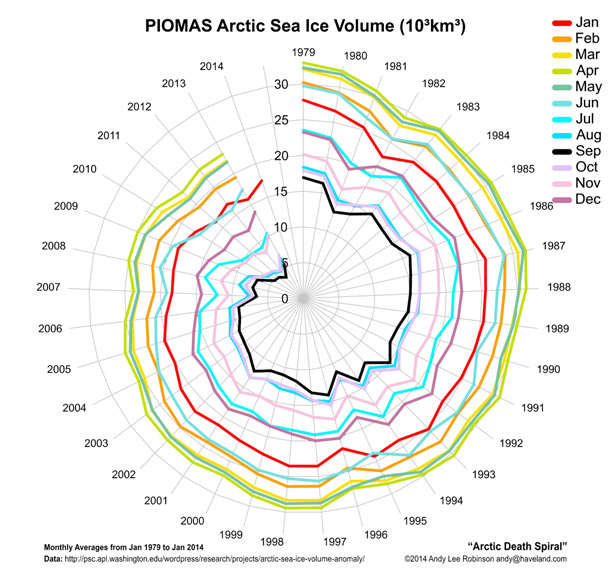
The “Arctic Death Spiral,” which shows how sea ice extent is spiraling through time towards oblivion. (Photo: Andy Lee Robinson, Creative Commons)
WADHAMS: Well, it was not invented by me but a scientist called Mark Serreze at the University of Colorado, and it's a way of representing the decline in the volume of ice in the Arctic on a month-by-month, year-by-year basis. So, what you do is have a clock shaped graph where, going out from the center, you have the volume of ice during each month of each year. So, you start off in the 1970s where the data began, and then you move around the clock clockwise, for each month looking at how the volume changes from year to year, and if there was no change going on, then each of the curves for each month would be a circle. So, you'd have a bunch of concentric circles, but because the ice is thinning and retreating the curves actually draw in towards the center, so it's like a spiral. And September is the month that will reach the center first because that's the month with minimum area of ice, and so it's a death spiral in the sense that first September will reach the center and wipe itself out for ice cover and then a few years later probably be July, August, October, and November while the ice remains in the winter, but its volume still decreases.
PALMER: So, what are the implications of that graph as you see it?
WADHAMS: Well, implications are that the Arctic is changing from being a permanent ice cover to becoming a seasonal one, and that will have big changes on ocean currents to circulation of the atmosphere, fisheries as well, and especially to the air temperature which will warm up because there isn't any ice cooling the surface anymore, and that will have an effect, for instance, on air currents over Greenland which will increase the melt rate of the Greenland ice sheet.
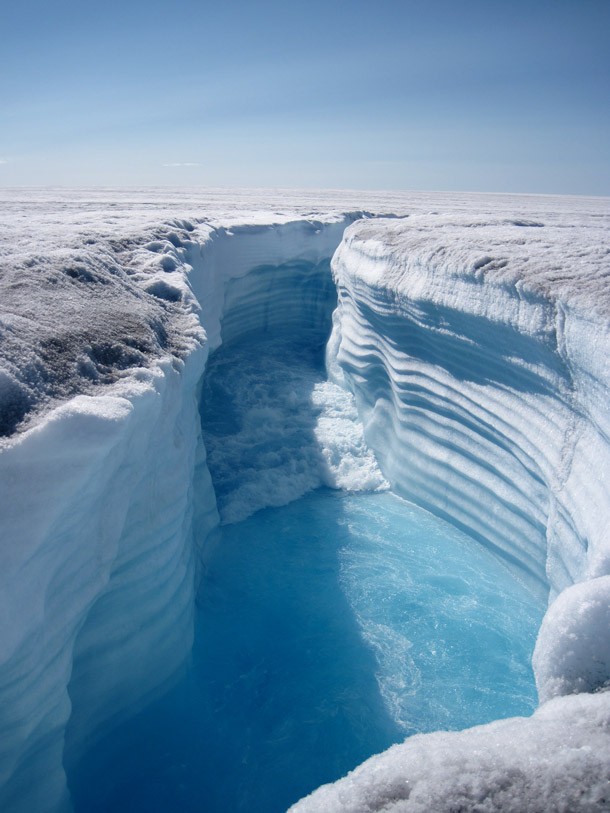
Surface melt water erodes channels into the Greenland ice sheet, eventually reaching the sheet’s bed and making it slip away into the sea faster. (Photo: Henry Patton, Flickr CC BY 2.0)
PALMER: Now, obviously the increase of Carbon Dioxide in the atmosphere, which we are very aware of from about 280 parts per million to over 400, is one of the major causes of the warming we're seeing. What other causes are there of this warming?
WADHAMS: Well, CO2 is probably the main source, but there is also an increased warming due to methane. We're finding increased methane emissions partly from the fact that people are careless with gas pipelines and fracking, and we're getting more methane going into the atmosphere from those sources, and partly it's methane coming from shallow water in the Arctic where underneath the shallow Arctic continental shelves there’s frozen ground, there's permafrost left over from the last ice age, and that permafrost acts as a cap over lots of methane contained in the sediments. That cap is being removed as the permafrost melts and the methane is being released.
PALMER: And of course methane in the short-term is a very powerful greenhouse gas. Are we certain that it is actually escaping? Are we seeing it escaping in the polar oceans?
WADHAMS: Oh, yes we're seeing it escaping every year. There’s a research voyages into the Russian Arctic seas – that's the Siberian Sea and the Kara Sea – and it's just more and more every year. The fear is that all the permafrost will melt in one rapid go, and then the amount of methane that comes out will be a huge pulse, and that would have a detectable climate change, in fact, maybe 0.6 of a degree is something we modeled, very rapidly, so it would be a just a big jerk to the world climate.
PALMER: And of course the idea is to keep the global temperature below two degrees Celsius, and we're already at about 1.2 degrees Celsius of warming. So, 0.6 takes us virtually there.
WADHAMS: Yes, but we're at 1.2 and even without any further carbon dioxide emissions we'll probably rise to two because not all of the intrinsic warming that's given by certain carbon dioxide level actually is realized immediately. It takes years for the effects to come through in the temperature of the oceans, for instance. If we stopped emitting carbon dioxide and just stayed put, the temperature would still rise for a while.
NASA video: Arctic Sea Ice from March to September 2017. (Credit: NASA's Scientific Visualization Studio/Helen-Nicole Kostis)
PALMER: There's another problem with the ice being gone; it does also have a kind of like a feedback effect on heating up the Arctic. Can you explain that?
WADHAMS: Well, yes, in fact the strongest effect on accelerating Arctic warming is the fact that as the ice retreats you're replacing a surface that reflects about 80 percent of the radiation from the sun straight back into space.
PALMER: That's because there's ice and snow and white cover.
WADHAMS: Yes, it is white and solar radiation is in the visible band, and so the fact that is white shows it’s reflecting, and you replace that by dark water or on land by dark tundra and that reflects only 10 percent or less of the energy falling on it, so you're changing from 80 percent reflection to 10 percent reflection and that's a huge extra amount of radiation absorbed by the Earth's surface or the ocean surface, and really increases the way of warming. That's called the albedo feedback.
PALMER: And of course another important factor of the polar ice cap was that it helped to cool the climate generally. It was this great air conditioning sort of system that it created and we're losing that.
WADHAMS: Yes, because it had a lot of effects. The fact that the sea ice was still there in the summer meant that it stabilized the air temperature at being not higher than zero degrees because if the air temperature got warmer it would just melt some of the surface snow and ice and it was an air conditioning system for the air, but it was also an air conditioning system for the ocean, that the ocean couldn't warm beyond zero degrees because otherwise the ocean heat would melt some of the ice from below. So, as long as there was still ice there to be melted, it kept the temperature of the atmosphere and the temperature of the ocean at about zero degrees. So, that prevented warm air from wafting over Greenland, which it’s now free to do, and it prevented warm water from melting the subsea permafrost, which it is now doing. So, it was performing two very useful functions both of which have now stopped.
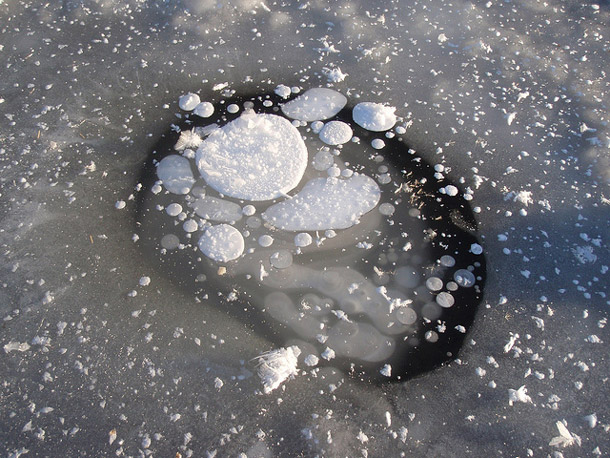
Methane bubbles frozen in lake ice in Alaska. As the Arctic thaws, permafrost on land and continental shelves in shallow waters are releasing methane into the atmosphere at an increasing rate. (Photo: Miriam Jones, USGS Flickr public domain)
PALMER: Several countries do see that there are economic opportunities in the ice-free Arctic, certainly for shipping and fossil fuel developments and new fishing grounds. What is your take on that?
WADHAMS: Well, we did an analysis of the costs of global warming. This was based on the model used by the Stern Review which was the review for the UK government on climate change costs, and even a methane release, which is a burst of methane giving a 0.6 degree warming, would be the equivalent (in terms of economic cost) of about 60 trillion dollars which is a fraction of what the total cost of global warming, really, but It's the cost of that amount of warming. Now if we're talking about trillions of dollars of cost to the world for global warming, then the billions of dollars which you can make out of increased shipping across the Arctic or increased rate of oil drilling becomes trivial.
PALMER: Now, early in your career you did some absolute fascinating research on the effects of oil in the Arctic, and obviously one of the plans of certainly the Soviets and indeed the current government in the US is to increase drilling in the Arctic. What did you find about the effects of oil when it's spilled in Arctic waters?
WADHAMS: Well, the effects of an oil spill are pretty frightening. When I was working on it full time, when I was in Canada you were allowed to do oil spills in the open sea to study what the effects were and we – we did an oil spill all through winter in a bay in the Canadian Arctic and then spilled some more oil under ice, and what we find is that oil when it's spilled under ice through a blowout on the seabed, the oil collects under the ice and then gets incorporated in the ice by new ice growing underneath the oil, so you have what's called an oil sandwich, and the ice drifts away because the ice is moving, and over winter you can have a huge area of the Arctic covered with ice floes which contain oil sandwiches. You can't detect the oil because it's incorporated in the ice, but as soon as summer comes along and the ice floes melt, the oil starts to come out and you find a vast area of the Arctic with little pockets of oil coming out from the melting ice which is virtually impossible to clean up.
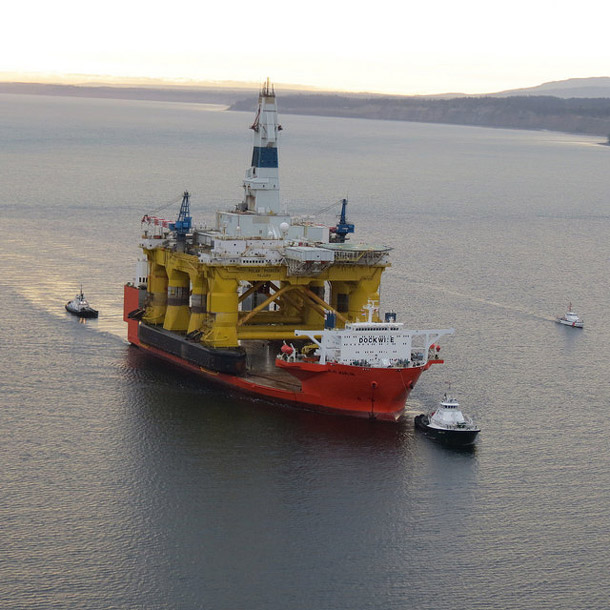
An oil spill in the Arctic would be far more difficult to clean up than elsewhere, says Peter Wadhams. The Royal Dutch Shell Oil drilling rig Polar Pioneer is shown above. As of September 2015 Shell has suspended its Arctic offshore drilling program. (Photo: Air Station Port Angeles / U.S. Coast Guard, Flickr CC BY-NC-ND 2.0)
It will be far more expensive than the Gulf of Mexico spill, for instance, and I think it's had an effect; when we wrote the report and published it, Shell was busy exploring in the Chukchi Sea and that year they just gave up. They said it was because there wasn't any oil, wasn’t any good oil. But we suspect it was because it would be expected that if there were not a big blowout the company that did it would have to foot the bill with the way that BP did with the Deepwater Horizon, so, they decided probably it was more fruitful to go do some fracking instead.
PALMER: So, obviously you're painting a pretty sort of dire picture for us of where we're going with the ice. So, you do propose something like a geoengineering approach at least for the short term. I mean isn't that sort of like a counsel of despair really?
WADHAMS: Yes, it's a counsel of despair in a way and also there's a very legitimate criticism that if you do something that gets rid of global warming or hides global warming, then it enables everybody to carry on with their nasty habits and not reform and be more virtuous, and that's absolutely true, but the trouble is it's very hard to make the human race reform and be virtuous. They would far rather carry on living the way they're used to living, and the feeling which I suppose is the tragedy of the commons is why should I give up my SUV just because it emits a lot of CO2 when it's only going to have a tiny effect on global warming? So, we have to go to the technological solutions because we can't depend on people's virtues for the solution of abstaining from emitting carbon dioxide.
PALMER: So, there are several potential solutions. Tell me about the one that you think has the most valiancy.
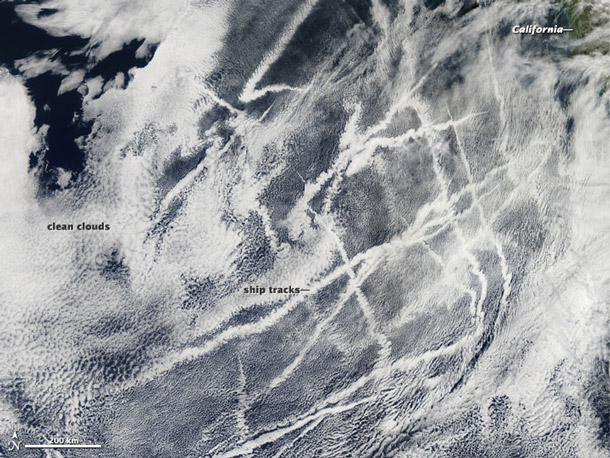
Above, a satellite image shows “ship tracks” across the Pacific Ocean, which form when water vapor condenses around tiny particles of pollution that cargo ships emit. This is the phenomenon that marine cloud brightening would seek to take advantage of to cool the Earth. (Photo: Jeff Schmaltz, LANCE/EOSDIS MODIS Rapid Response Team at NASA GSFC, Flickr CC BY 2.0)
WADHAMS: Well, there's two that I think would work. The first one is to hold back global warming although it doesn't affect carbon dioxide levels and it doesn't affect what that's doing to the oceans, but to hold it back is a method called marine cloud brightening where you have a drone ship drifting around with very tall masts which inject a carefully calculated size of tiny sea water droplets into the bottoms of clouds and that brightens the cloud up because of the small size of these particles and increases albedo which could hold back global warming, and the advantage of that is that the effects stops as soon as you stop applying it. So, if there's some accidental bad effect on some part of the world, you can simply stop. Whereas other methods like releasing aerosols into the stratosphere, you can't do anything, you have to wait until it falls out of the stratosphere, but it's still not a solution. It's a sticking plaster. A real solution is taking carbon dioxide out of the atmosphere, and I think we have to do that if we're going to save the world in the long term.
PALMER: Professor Wadhams, is it possible that your conclusions are too pessimistic?
WADHAMS: Well, actually I'd like to think of mine as optimistic because a lot of people who analyze the situation of the planet and write polemical accounts are so despairing that they end up saying, “We're doomed so we should all go and live on mountain tops with guns and so on.” I think that's bad because we do have ways to save ourselves and I think geoengineering is a way to stop the warming getting to the point where it's very very seriously affecting our society, and CO2 removal is something that I think will work because it does work already, but it just costs too much but it will be made to be cheaper and when it's made to be cheaper it can save us so I think we can save ourselves.
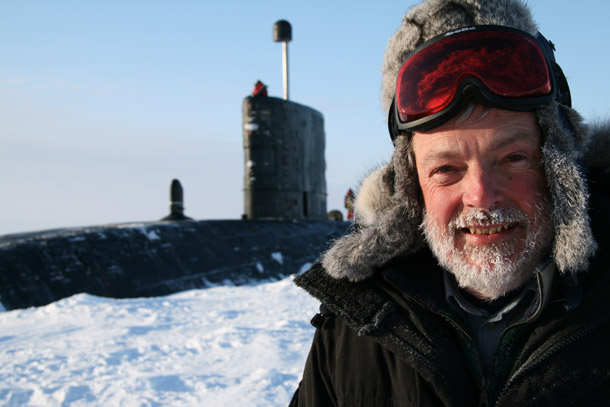
Peter Wadhams is the author of A Farewell to Ice and Professor of Ocean Physics at Cambridge University, where he directed the Scott Polar Research Institute from 1987 to 1992. (Photo: courtesy of Peter Wadhams)
And the optimistic thing is we can save ourselves without becoming more virtuous because if we can find a way to get rid of CO2 in the atmosphere, then people who want to drive Ferraris around and SUV and so on can keep on doing so up to a point. You know, you're not going to forcibly abolish fossil fuels, so we don't have to become suddenly virtuous people. We can combine it with still keeping some of our old habits which means it's more likely to happen.
CURWOOD: Cambridge University professor Peter Wadhams book, A Farewell to Ice, is based on nearly 50 years of research in polar waters. He spoke with Living on Earth’s Helen Palmer.
Related links:
- A Farewell to Ice: A Report from the Arctic
- NASA: Arctic Sea Ice Minimum
BirdNote®: Spooky Shearwaters
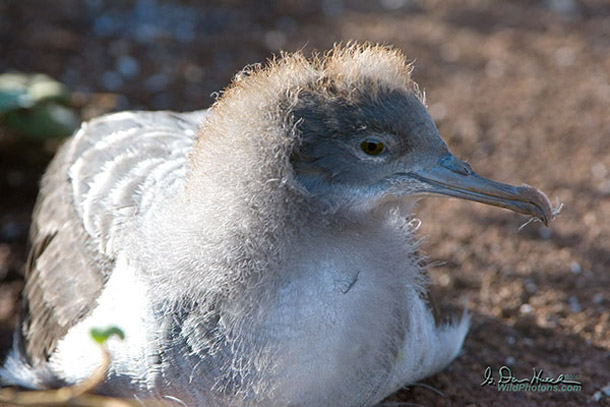
The Wedge-tailed Shearwater’s unusual moaning call once terrified sailors from Europe. (Photo: Dan Hutcheson)
[MUSIC - BIRDNOTE® THEME]
CURWOOD: At Halloween, we think of ghoulies and ghosties and long-leggitty beasties – indeed, you may even get some of them at your door demanding candy. And as Michael Stein tells us in today’s BirdNote®, some of our avian acquaintances would fit right in.
http://birdnote.org/show/spooky-shearwaters
BirdNote®
The Spooky Shearwaters
STEIN: Imagine yourself an 18th Century sailor, rowing out from your boat at night toward a remote Pacific island. You’re heading to the island to find fresh water for the ship, only to be greeted by this frightful moaning.
[Wedge-tailed Shearwaters wailing]
Some early sailors feared this ungodly wailing meant they had been tricked ashore at the gates of Hell itself, when in truth they stood shuddering among courting pairs of seabirds called Wedge-tailed Shearwaters.
[Wedge-tailed Shearwaters wailing]
Dark, gull-sized seabirds with long, thin, tapering wings, Wedge-tailed Shearwaters nest on islands in the tropical Pacific and Indian Oceans, from Hawaii to western Australia to Madagascar. Most dig burrows to nest in, two to six feet deep with a bend that allows the incubating birds to rest unseen. From dusk to midnight during courtship, pairs of Wedge-tailed Shearwaters sit facing one another on the ground, and puff up their throats to perform long duets of eerie wailing – sometimes sending spooked sailors rowing in panic back to their ship for a ration of grog.
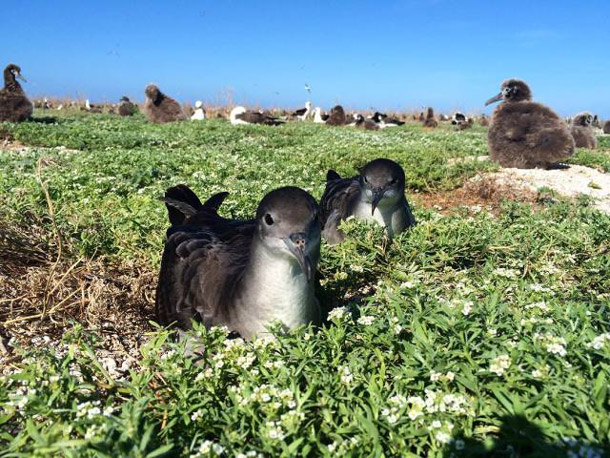
Wedge-tailed Shearwaters nest on the ground. Their range stretches from Hawaii and the Pacific all the way to the beaches of Madagascar. (Photo: US Fish and Wildlife Service)
[Wedge-tailed Shearwaters wailing]
I’m Michael Stein.
###
Written by Bob Sundstrom
Call of the Wedge-tailed Shearwaters provided by The Macaulay Library of Natural Sounds at the Cornell Lab of Ornithology, Ithaca, New York. Wedge-tailed Shearwater 1801 recorded by F.N. Robinson
Ambient ocean sound recorded by John Kessler
BirdNote's theme music was composed and played by Nancy Rumbel and John Kessler
Producer: John Kessler
Executive Producer: Dominic Black
© 2005-2017 Tune In to Nature.org October 2017 Narrator: Michael Stein
CURWOOD: [CACKLES GHOULISHLY] And for pictures, haunt our website, loe dot org.
Related links:
- The “Spooky Shearwaters” story on the BirdNote® website
- Learn more about the Shearwater from the Cornell School of Ornithology
[MUSIC: Grim Grinning Ghosts (Instrumental)
https://www.youtube.com/watch?v=gyl-ixDvHZ0]
CURWOOD: So next week I hope we’ll have more cheerful news! Living on Earth is produced by the World Media Foundation. Our crew includes Naomi Arenberg, Bobby Bascomb, Savannah Christiansen, Jenni Doering, Noble Ingram, Jaime Kaiser, Don Lyman, Helen Palmer, Adelaide Chen, and Jolanda Omari. Special thanks today to One Ocean Expeditions, Tom Tiger engineered our show, with help from Jeff Wade and Jake Rego. Alison Lirish Dean composed our themes. You can find us anytime at LOE.org – and like us, please, on our Facebook page – it’s PRI’s Living on Earth. And we tweet from @LivingonEarth. I'm Steve Curwood. Thanks for listening.
ANNOUNCER1: Funding for Living on Earth comes you, our listeners, and from the University of Massachusetts, Boston, in association with its School for the Environment, developing the next generation of environmental leaders. And from the Grantham Foundation for the protection of the environment, supporting strategic communications and collaboration in solving the world’s most pressing environmental problems. Support also comes from the Energy Foundation, serving the public interest by helping to build a strong, clean, energy economy, from Gillman Ordway and from SolarCity, America’s solar power provider. SolarCity is dedicated to revolutionizing the way energy is delivered by giving customers a renewable alternative to fossil fuels. Information at 888-997-1703. That’s 888-997-1703.
ANNOUNCER2: PRI. Public Radio International.
Living on Earth wants to hear from you!
Living on Earth
62 Calef Highway, Suite 212
Lee, NH 03861
Telephone: 617-287-4121
E-mail: comments@loe.org
Newsletter [Click here]
Donate to Living on Earth!
Living on Earth is an independent media program and relies entirely on contributions from listeners and institutions supporting public service. Please donate now to preserve an independent environmental voice.
NewsletterLiving on Earth offers a weekly delivery of the show's rundown to your mailbox. Sign up for our newsletter today!
 Sailors For The Sea: Be the change you want to sea.
Sailors For The Sea: Be the change you want to sea.
 The Grantham Foundation for the Protection of the Environment: Committed to protecting and improving the health of the global environment.
The Grantham Foundation for the Protection of the Environment: Committed to protecting and improving the health of the global environment.
 Contribute to Living on Earth and receive, as our gift to you, an archival print of one of Mark Seth Lender's extraordinary wildlife photographs. Follow the link to see Mark's current collection of photographs.
Contribute to Living on Earth and receive, as our gift to you, an archival print of one of Mark Seth Lender's extraordinary wildlife photographs. Follow the link to see Mark's current collection of photographs.
 Buy a signed copy of Mark Seth Lender's book Smeagull the Seagull & support Living on Earth
Buy a signed copy of Mark Seth Lender's book Smeagull the Seagull & support Living on Earth

